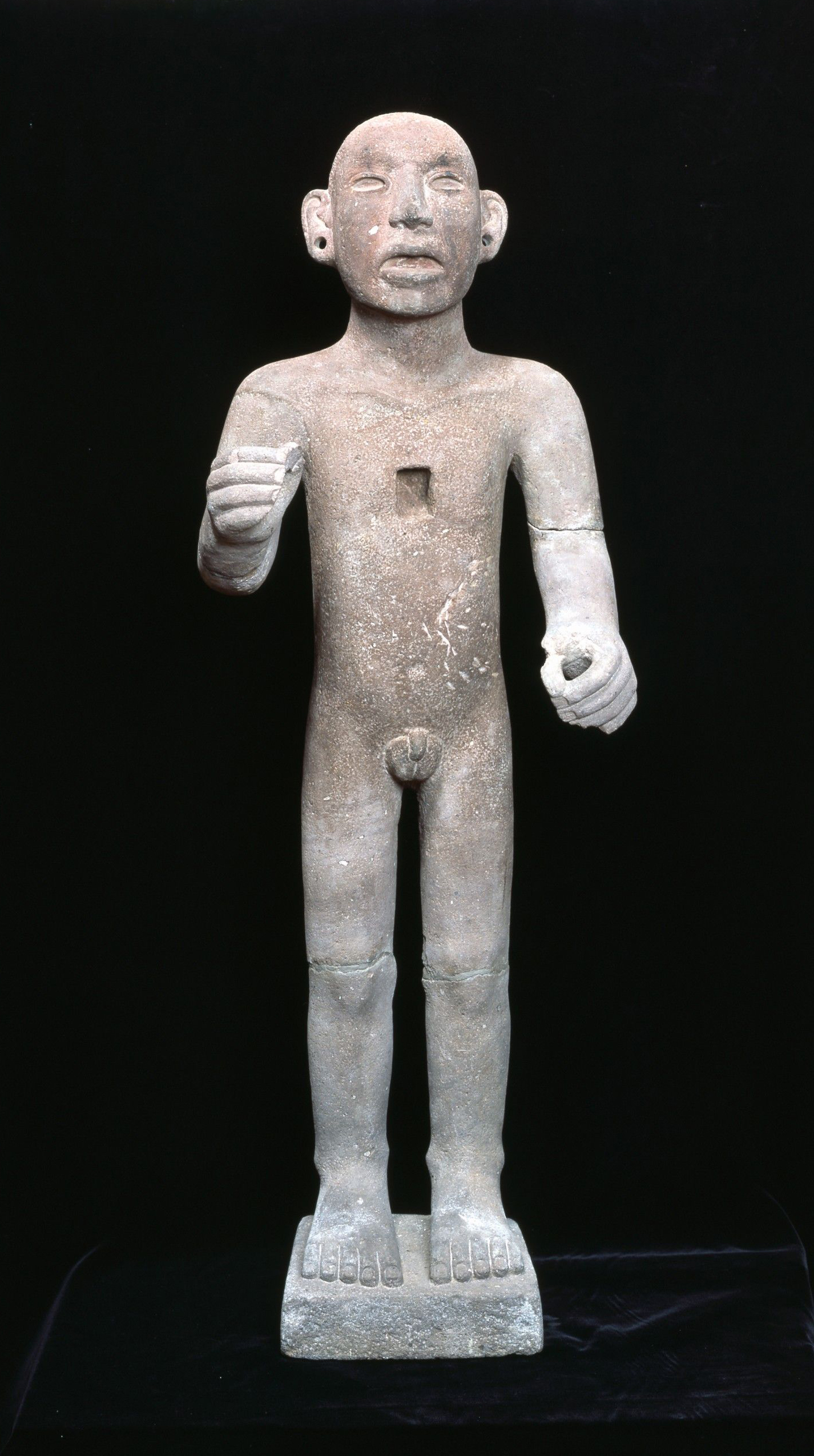At just over three and a half feet tall, the Mexica sculpture of a standing male nude known as Stone Statue of a Young Man has been a keystone of the Yale Peabody Museum’s collection since its acquisition in 1881. Carved in a cool, gray basalt found in the mountains of Puebla, it boasts the frontality and severity of the Mexica (formerly “Aztec,” 1300–1521 CE) artistic tradition while remaining unique among other examples in that the figure is unclothed and unadorned.
Although Mexica artists were not known for realism, they achieved a degree of naturalism in their sculptures through their careful attention to anatomical details. In Stone Statue of a Young Man, note the precise definition of the clavicle, the pisiform (the bone on the outer side of the wrist), and the lateral malleolus (the bone on the outer side of the ankle), which appear to emerge from the figure’s soft flesh. The result is a stunning depiction of youth, beauty, and the human body. Scholars generally think that the rough, rectangular niche carved into the figure’s chest was intended for the insertion of a precious object (perhaps jade), which the Mexica believed would metaphorically bring the figure to life.
While known today as Stone Statue of a Young Man, the sculpture has had many names during its one hundred fifty years at Yale. It initially arrived at the Peabody Museum as part of the Avery Judd Skilton collection. In the collection’s original catalog, it was referred to as an Aztec “Idol of Stone.” First acquired by Julius A. Skilton, a onetime US consul in Mexico City and son of Avery, a Yale Medical School graduate, it was purchased from him by Othniel Charles Marsh, curator of the Peabody’s anthropology division. In the sculpture’s original description, Julius Skilton concluded that the sculpture might represent a supernatural young boy between the ages of nine and ten. In early Peabody catalogs, Marsh maintained this designation.
While the sculpture is inarguably youthful, it is doubtful that it represents someone as young as nine. There are no known sculptures of Mexica children, save for those depicting women with their babies. Further, sculptures of idols or supernatural figures usually included decorative elements or a costume. Because this figure is nude, it more likely represents a young male captive, or perhaps a soldier of high status. From the earliest periods at Monte Albán (600–200 BCE) in Central Mexico, temple entrances were decorated with statues of humiliated—that is, naked—captives, usually individuals of high standing. Their display brought prestige to the temple owners. Although the Mexica had no official flag, temple complexes are thought to have displayed regional banners and textiles at their entrances. It is therefore also possible that Stone Statue of a Young Man once flanked an important threshold while holding a banner, in the mode of a standard-bearer.
After its purchase, the sculpture was soon absorbed into the collection of the Peabody and exhibited in the museum’s first building on the corner of High and Elm Streets. In 1915, a letter appeared on the desk of George Grant McCurdy, the anthropology division’s curator, offering the museum the “hands belonging we think to the Aztec idol of the Skilton-Marsh donation.” Further correspondence indicates that the offer was eagerly accepted, which suggests that the sculpture was previously exhibited with a different pair of hands than it has today. At one point in its history, the sculpture was given the title “Xipe Totec,” a specifically Mexica god who was known for wearing the flayed skin of a sacrificial victim, perhaps as a testament to the life that emerges from death. While most sculptures of Xipe Totec depict him in the nude, they also feature ties up the back and additional sets of hands and feet hanging from the wrists and ankles to indicate that he is wearing a second skin. It is possible that Stone Statue of a Young Man was once dressed as Xipe Totec, but there is no strong evidence to support this possibility.
In 1963, the sculpture was featured in curator Michael D. Coe’s pivotal exhibition From Mexico to Peru, where it was labeled “Standing Male Nude,” all notions of its youth dropped. It was loaned to the Yale University Art Gallery in 2011 for its reinstallation of the Ancient Americas gallery, then returned to the renovated Yale Peabody Museum before it reopened in spring 2024.
—Brooke Luokkala, former associate registrar, anthropology, Yale Peabody Museum, and PhD candidate, Emory University

